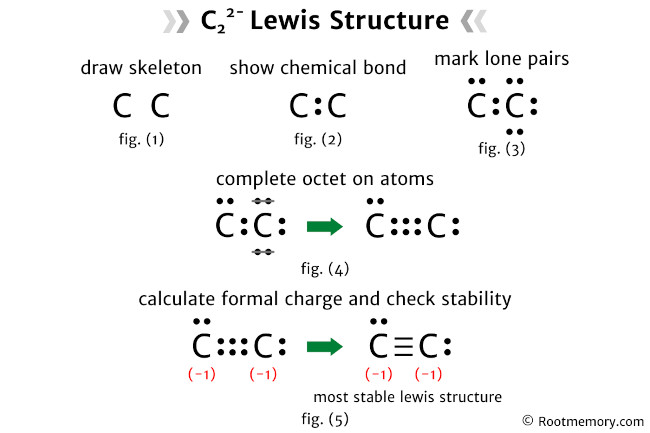
The Lewis structure of C22- contains a triple bond between the two carbon atoms, and each carbon atom has one lone pair.
Plus, there is a negative (-1) charge on each carbon atom.
Alternative method: C22- Lewis structure
Steps
Draw skeleton
In this step, first calculate the total number of valence electrons. And then, decide the central atom.
- Let’s calculate the total number of valence electrons
We know that… carbon is a group 14 element. Hence, carbon has four valence electrons.
Now C22- has two carbon atoms.
So the total number of valence electrons = valence electrons of carbon atom × 2
And C22- has a negative (-2) charge, so we have to add two more electrons.
Therefore, the total number of valence electrons = 8 + 2 = 10
- Now decide the central atom
There are two carbon atoms in C22-. Hence, we can assume any one as the central atom. Let’s assume that left carbon is the central atom.
So now, put two carbons next to each other. And draw the rough skeleton structure for the Lewis structure of C22- something like this:

Also read: How to draw Lewis structure of SeO32- (5 steps)
Show chemical bond
Place two electrons between the atoms to show a chemical bond as follows:

Mark lone pairs
As calculated earlier, we have a total of 10 valence electrons. And in the above structure, we have already used two valence electrons. Hence, eight valence electrons are remaining.
Two valence electrons represent one lone pair. So eight valence electrons = four lone pairs.
Note that carbon is a period 2 element, so it can not keep more than 8 electrons in its last shell.
Also, make sure that you start marking these lone pairs on outside atoms first. And then, on the central atom.
The outside atom is right carbon, so right carbon will get three lone pairs. And the central atom (left carbon) will get one lone pair.
So the Lewis structure of C22- looks something like this:

In the above structure, you can see that the octet is completed on the outside atom. But, the central atom (left carbon) doesn’t form an octet.
So in the next step, we have to complete the octet on the central atom.
Also read: How to draw Lewis structure of P4 (4 steps)
Complete octet on central atom
Remember that carbon is a period 2 element, so it can not keep more than 8 electrons in its last shell.
Now the left carbon already has four valence electrons. Hence, the left carbon needs four more valence electrons to complete its octet.
So convert two lone pairs from the right carbon atom to make a new bond with the left carbon atom. And then, the Lewis structure of C22- looks something like this:

In the above structure, you can see that the octet is completed on the central atom (left carbon), and also on the outside atom. Therefore, the octet rule is satisfied.
After completing the octet, one last thing we need to do is, calculate the formal charge and check the stability of the above structure.
Also read: How to draw Lewis structure of ClF (4 steps)
Calculate formal charge and check stability
The following formula is used to calculate the formal charges on atoms:
Formal charge = valence electrons – nonbonding electrons – ½ bonding electrons
Collect the data from the above structure and then, write it down below as follows:
- For each carbon atom
Valence electrons = 4
Nonbonding electrons = 2
Bonding electrons = 6
Formal charge = 4 – 2 – ½ (6) = -1
Mention the formal charges of atoms on the structure. So the Lewis structure of C22- looks something like this:

In the above structure, you can see that the formal charges of atoms are closer to zero. Therefore, this is the most stable Lewis structure of C22-.
And each horizontal line drawn in the above structure represents a pair of bonding valence electrons.
Now C22- is an ion having a negative (-2) charge, so draw brackets around the above Lewis structure and mention that charge on the top right corner. And then, the Lewis structure of C22- looks something like this:

Next: Lewis structure of SeO32-
Related
- Lewis structure of SeO32-
- Lewis structure of P4
- Lewis structure of ClF
- Lewis structure of NH2OH
- Lewis structure of S2O
External video
- C2 2- Lewis Structure: How to Draw the Lewis Structure for C2 2- (Acetylide anion) – YouTube • Wayne Breslyn
External links
- C22- Lewis Structure – Dicarbide Ion – The Geoexchange
- c22- lewis structure – Quizlet
- Draw a Lewis structure, including all lone pair electrons and nonzero formal charges, for the C22-ion – Chegg
- How would you draw the Lewis structure for C22- and how do you find the formal charges for each carbon atom – Course Hero
- Lewis Dot of Dicarbide C22- – Kent’s Chemistry
Deep
Rootmemory.com was founded by Deep Rana, who is a mechanical engineer by profession and a blogger by passion. He has a good conceptual knowledge on different educational topics and he provides the same on this website. He loves to learn something new everyday and believes that the best utilization of free time is developing a new skill.
